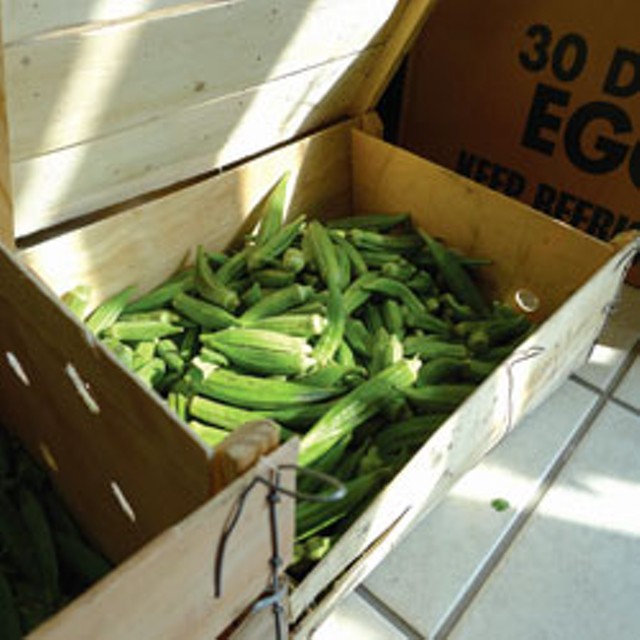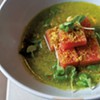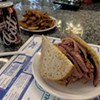Published June 6, 2012 at 9:41 a.m.
It takes about 20 minutes to walk uphill from the Winooski traffic circle to the Shaw’s supermarket in Colchester. That task might not sound too onerous, but the city’s sidewalk stops before it reaches the Interstate 89 overpass. Following Route 7 under the overpass is a treacherous endeavor, with only two-and-a-half feet between walkers — or bicyclists — and oncoming cars. Yet, because Shaw’s is the only supermarket near Winooski — where at least 44 percent of residents live more than a mile from a grocery store, according to the U.S. Department of Agriculture — there’s a well-worn footpath in the weeds just past the dangerous 89 intersection.
“Quite a few customers comment that they make the walk,” says Kim Brown, assistant vice president of financial services at the People’s United Bank branch located inside Shaw’s. “I live a half-mile away and would love to walk, but I will not cross under the intersection.”
Those who do brave the trip have little choice. Since both the IGA downtown and the Grand Union on Malletts Bay Avenue closed in the late 1990s, the Onion City has been without a grocery store — even as it has gained new condos, restaurants and an ever-growing, diverse population. Winooski has a coffee shop, nightclub, tattoo business, gym, gallery and two pho eateries, but it still lacks a single spot to purchase milk, bread, meat and veggies together, the farmers market notwithstanding.
“One of the most heartbreaking things in this town is the number of people who live here and don’t have cars and don’t have access to healthy food,” says Jodi Harrington, a longtime resident and former city councilor who has been involved in various efforts to attract a grocery store since she moved to Winooski in 1992. “It’s been very frustrating.”
Winooski’s supermarket vacuum was spotlighted last fall, when City Market’s board of trustees considered expansion into the burg, then turned its attention to another site that better fit its goals. The resulting public disappointment seems to have energized some of the city’s officials, both new and old, who are thinking out of the box to solve the issue.
“One of the things we’ve heard is that Winooski doesn’t fit the traditional mold,” says Sarah Robinson, who was elected to the city council in 2010. She thinks the city’s perceived problems — such as extreme density and lack of parking — could give rise to a new breed of market. “We’re not going to get a Shaw’s in downtown Winooski,” Robinson says. “We’re going to have to look at something that’s new and innovative and a little bit of a risk, something that may not exist anywhere else in the state of Vermont.”
In 2009, the U.S. Department of Agriculture classified Winooski and Burlington’s Old North End as “food deserts,” or low-income areas where a substantial number of residents have “low access to a supermarket or grocery store.” Vermont’s only other food deserts are in the Northeast Kingdom.
What city residents currently do have is a smattering of convenience stores with various food options. At Winooski Falls Market, a convenience store and deli in Keen’s Crossing, nearby employees and residents can grab a sandwich, salad, a gallon of milk, frozen chicken breasts, flour or Fiddle Faddle. But the only fresh produce on hand are a few bananas, apples and lemons.
The handful of ethnic food markets in town generally have a richer selection. On a recent visit, Namaste Asian Market on Main Street offered okra, sugar-snap peas, tomatoes, yams, duck eggs and a refrigerator full of mustard greens.
“To make a meal here [in Winooski], you really need to play piecemeal,” says Seth Leonard, a Winooski resident and new member of the Winooski Community Partnership, a volunteer, nonprofit organization seeking to revitalize downtown.
The longtime lack of a supermarket has motivated city officials to court various vendors over the years, including City Market. The leadership of the Burlington co-op was interested in a Winooski satellite as early as 2005, according to Harrington, who was City Market’s marketing manager when urban-development construction was beginning in Winooski. At the time, the developers of Keen’s Crossing included a roughly 4500-square-foot, ground-floor space inside the complex, intending it as an eventual grocery store.
Though that space is striking, it lacks a few key features — significantly, a loading dock. And so it remains vacant, other than the small portion occupied by the Winooski Falls Market, which opened two years ago.
When City Market announced plans last fall to build a second store, three potential sites were mentioned: Burlington’s South End, the Old North End and Winooski.
Representatives from City Market had already looked at the empty Keen’s Crossing space and found it inadequate to their needs. They’ve also looked at various other locations in town, but so far none has had the accessibility, parking or affordability to support City Market’s most immediate goal — to ease congestion at its Burlington store.
City Market’s recent study showed that better economic pastures — and more parking — lie elsewhere. “Our market study came back and said we should concentrate on the Pine Street area [in the South End],” says general manager Clem Nilan. While popular support for a Winooski market is high, residents of the other two locations are clamoring for their own City Market, too, he adds. Expanding into an area solely as a “goodwill exercise” might not fly with a bank or with the co-op’s members. “A lot of factors go into deciding this,” Nilan says. “A large project of this nature needs to take into account fiscal responsibility as well as the needs of any community of which we’ll be a part.”
When it seemed clear that City Market wasn’t heading north, angst poured out in dozens of messages on Front Porch Forum. “The City Market expansion possibility was really exciting for a lot of folks in Winooski,” says City Councilor Robinson. “Now we’re trying to figure out where we go next. One thing we’re really clear about is, we don’t want another convenience store.”
That view is echoed by Leonard, who works at Opportunities Credit Union and sits on the economic-development committee of the Winooski Community Partnership. (“The city of Winooski recently folded the job of community development director into a broader, more service-based position, so the WCP has taken up some of the slack with regard to economic development.”) The partnership is battling “the negative perception of Winooski [as] not being a great shopping base for a health-foods market of some kind, not being wealthy enough to support organic food,” he says. “Tens of thousands of cars pass through our city limits every day. We had $55,000 in sales at our farmers market [last season].”
Though Nilan points out that Winooski is not completely out of the running for an eventual store, Leonard and others are plunging ahead with their explorations. “There’s a bunch of people not waiting around for [City Market],” he says. “People need access to fresh food, and we can’t force a board of trustees to make a decision. It’s in all of our interests to solve this serious food and socioeconomic crisis. There is a human side to this,” Leonard adds.
In addition to identifying sites for a permanent market — for instance, the city owns a lot adjacent to the Champlain Mill that might be ideal — the city and its activists have been looking to other models around the state, as well as to urban innovations such as mobile vendors. “If we have to get all guerrilla about it, at least that’s a possibility,” Leonard says.
He has been working closely with a family that owns both a Fairfax farm and a vacant lot in Winooski, and says the farmers are poised to set up a produce stand in the city this summer, “three or four days a week.”
Seth Gillim, who moved to Winooski in 2010 with his family and serves as chair of the city’s planning commission, says it is important to embrace Winooski’s differences and challenges as opportunities. “The grocery that Winooski gets will probably be the first of its kind in Vermont. It’s not going to be a 30,000-square-foot [store] like City Market; it will probably be 8000 to 15,000 square feet and will cater to a variety of income groups and tastes,” Gillim predicts. “It just takes the right entrepreneur who is passionate about Winooski. This isn’t a desire of ours — it’s a need. We need somewhere to buy milk, dinner and some diapers for our kids.”
Winooski Mayor Michael O’Brien remembers when his mother shopped for groceries at Winooski’s IGA, which was sacrificed in the latest round of urban development. Though he says the city has talked to “several people” over the years about opening a market — to no avail — O’Brien sounds optimistic that the forward momentum and imaginative thinking of the new city council and community partnership will reverse Winooski’s poor grocery fortunes. “It’s a great opportunity for a market, and we’re looking at a flexible approach with a product mix and possibly multiple vendors,” O’Brien says. “Though, as of yet, there’s really nothing on the table.”
An eventual Winooski market might resemble those common in more urban areas. “Maybe what the future holds isn’t a grocery store per se, but maybe we become the best town in terms of corner markets,” Gillim speculates. “Maybe the future doesn’t look that different than the past.”
However it will look, Robinson hopes the city will have its market within three years. Leonard agrees. “From a social and political perspective, it is time for us to move on. We need to look inward for ideas and vision that will solve the problem,” he says. “Not that we won’t be recruiting someone from the outside.”
More By This Author
Speaking of...
-

Q&A: Howard Fisher Delivers Meals on Wheels With a Side of Good Cheer
Dec 20, 2023 -

Video: Howard Fisher Delivers Meals on Wheels
Dec 14, 2023 -

Q&A: Alexis Dexter Rescued 57 Shelter Cats During the July Flood
Sep 13, 2023 -

Video: Two Months After the Flood, Alexis Dexter Rebuilds Kitty Korner Café in Barre and Continues to Rescue Cats
Sep 7, 2023 -

Video: Saying Goodbye to Burlington’s Penny Cluse Café
Nov 17, 2022 - More »
Comments
Comments are closed.
From 2014-2020, Seven Days allowed readers to comment on all stories posted on our website. While we've appreciated the suggestions and insights, right now Seven Days is prioritizing our core mission — producing high-quality, responsible local journalism — over moderating online debates between readers.
To criticize, correct or praise our reporting, please send us a letter to the editor or send us a tip. We’ll check it out and report the results.
Online comments may return when we have better tech tools for managing them. Thanks for reading.














































